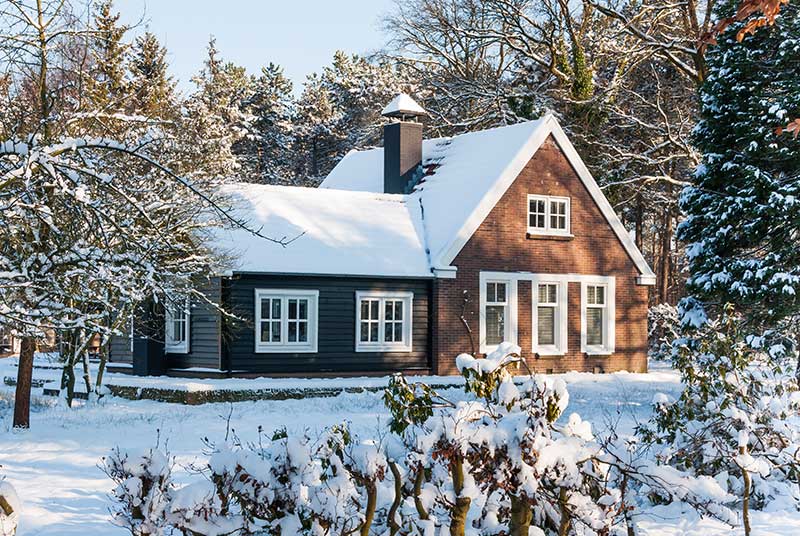Before lighting your fireplace for the winter, there are a couple of things you will want to do to prepare. Not only will this help keep your fireplace and chimney clean and clear, but it will also benefit your chimney’s longevity.
All chimneys need to be inspected and cleaned. Most people take care of it at least once a year to prevent any issues that could occur, such as a chimney fire. By cleaning your chimney, you can remove any buildup that could become flammable.
So, how can you prepare your chimney for the winter? Read on to learn our top tips and tricks for preparing your fireplace and chimney for the colder months!
Preparing your Fireplace
In addition to preparing your chimney, you should also preparing your fireplace. Since it has probably been a few months since you last lit your fireplace, you want to ensure that some key components are cleaned and cleared. To start, focus on the following areas:
Clean Your Clutter
If you only use our fireplace in the winter, you may end up cluttering the surrounding area during the off-season. By cleaning it up, you will avoid potential fire hazards that can occur when you wish to start using your fireplace. Remove any objects sitting in front of your fireplace, including furniture or miscellaneous items. Also keep rugs and other flammable items safely away from the fireplace.
Check the Fireplace Gasket
For most gas and wood fireplaces, you will find that there is a gasket right near the door of the fireplace. This is there to keep smoke and gas from infiltrating the indoor space surrounding the fireplace. This should be inspected frequently, or at least once a year, to ensure it is working properly. If it looks damaged, be sure to replace it.
Check Carbon Monoxide Alarms
Smoke and carbon monoxide alarms are a necessity if you own a gas or wood fireplace. These are installed in your home to keep you and others safe in the event that something occurs in the event of potential carbon monoxide build-up, such as having an improperly ventilated fire. Before lighting a fire in your fireplace, check the batteries and test to see if the alarms are working.
Checking Your Chimney
In addition to checking your fireplace, you will also want to check your chimney. You can do this by hiring reliable and knowledgeable professionals, such as the experts available at Soot Serv. Getting your chimney checked and cleaned at least once a year is very important and should not be skipped.
To help guide you, here are the following parts of the chimney that need to be checked prior to lighting your fireplace:
Chimney Cap
Chimney caps function to keep out debris and natural elements such as rain, birds, and leaves. These elements can be potentially dangerous for the longevity of your chimney when you are ready to use it. Therefore, if your chimney cap is damaged or missing before you want to use your fireplace, you should replace it.
Tree Maintenance Near the Chimney
Many people have trees growing in their yards. Why would this be a problem? Well, if you have a tree growing too close to your home and hanging over your roof, it could pose a risk. Tree branches are definitely fire hazards. They can also cause damage to the chimney cap if they are to fall in a storm. Check the tree limbs nearby to ensure they are not in a dangerous position.
Check for Damage
Before using your chimney in the winter, check for damage. While a professional should do this annually, some can get away with checking it less frequently. Ideally, it is done once a year. Even little cracks, loose bricks, or internal structural damage can occur without you realizing it. These little bits of damage can also occur slowly over time, so you may not even know they have happened. Get any of these issues fixed before utilizing your fireplace in the winter.
Get Your Chimney Swept
A chimney sweep can be done by professionals in your area, such as SootServ, and should be done at least once a year, even if your chimney does not require any other repairs. Built-up soot, creosote, and debris can cause damage and put you at risk for a fire. If you want to keep your fireplace in tip-top shape, you will want to get your chimney swept at least once a year before using your fireplace in the winter.
Damper Function
The damper is what regulates the airflow inside your flue. Usually, can be opened or closed with a rod or pull chain. The damper should generally be closed when the fireplace is not in use; and to get adequate airflow, you will need to open the damper to start a fire. Open and close it a couple of times before lighting a fire to ensure it works properly. If it is working, you should feel a light breeze.
Prepare Your Chimney
Before you try to light a fire in your fireplace this winter, consider getting your chimney checked and cleaned by reliable and knowledgeable professionals in the industry. Consider working with SootServ to take care of your chimney sweeping. To get in touch with them to check your chimney, click the link here or call (225) 572-6678.



